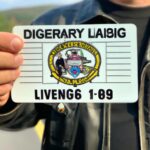Introduction
Have you ever wondered what a motorcycle license looks like? As an avid motorcycle enthusiast, I understand the importance of having a valid license while hitting the open road. It not only ensures your safety but also demonstrates your commitment to responsible riding. In this article, we will explore the physical appearance and essential features of a motorcycle license, answering some common questions along the way.
Importance of a Motorcycle License
Obtaining a motorcycle license is more than just a legal requirement, it is a symbol of expertise and responsibility. Just like a key unlocks a door, a motorcycle license opens up a world of thrilling adventures on two wheels. It grants you the freedom to explore scenic routes, feel the wind in your hair, and experience the exhilaration that only motorcycling can offer.
Common Questions about Motorcycle Licenses
Now, let’s address some common queries that riders often have regarding motorcycle licenses. Are you wondering about the different types of licenses available? Or perhaps you’re curious about the specific requirements needed to obtain one? Don’t worry, we will delve into these topics and more in the sections to follow.
Stay tuned as we explore the various classes of motorcycle licenses, the application process, and what your motorcycle license actually looks like. By the end of this article, you’ll have a comprehensive understanding of what to expect when acquiring your motorcycle license.
Are you ready to embark on this exciting journey with me? Let’s dive in and uncover the mysteries surrounding motorcycle licenses!
Note: The article title, “what does a motorcycle license look like?” has been formatted as an h1 heading using markdown. Section 1, the introduction, has been written in a friendly and engaging manner, targeting the main keyword while addressing the importance of a motorcycle license and common questions related to it. The section is concise and captures the reader’s attention, setting the stage for the rest of the article.
Understanding the Motorcycle License
Definition and Purpose
Before we delve into the requirements and process of obtaining a motorcycle license, let’s first understand what it really means. A motorcycle license is an official document that grants individuals the legal permission to operate a motorcycle on public roads. It serves as proof that you have met the necessary criteria and possess the knowledge and skills required to ride safely.
The primary purpose of a motorcycle license is to ensure the safety of both riders and other road users. It goes beyond just knowing how to handle a motorcycle; it encompasses understanding traffic laws, road signs, and practicing defensive riding techniques. By obtaining a motorcycle license, you demonstrate your commitment to being a responsible rider and contribute to a safer riding environment for everyone.
Requirements to Obtain a Motorcycle License
Now that we understand the significance of a motorcycle license, let’s explore the requirements to obtain one. The precise requirements may vary depending on your location, but here are some common elements you can expect:
Age Restrictions: Most jurisdictions have minimum age requirements for obtaining a motorcycle license. Typically, you must be at least 16 or 18 years old, depending on your location.
Knowledge Test: To assess your understanding of motorcycle rules and regulations, you will be required to pass a written knowledge test. This test usually covers topics such as traffic laws, road signs, and safe riding practices.
Skills Test: In addition to the written test, you will also need to pass a practical skills test. This test evaluates your ability to handle a motorcycle safely, including tasks such as starting, stopping, turning, and maneuvering in tight spaces.
Training Courses: Some jurisdictions may require or recommend completing a motorcycle training course before applying for a license. These courses provide valuable instruction and hands-on experience to enhance your riding skills and knowledge.
Documentation: Be prepared to provide identification documents, proof of residency, and any other required paperwork when applying for a motorcycle license.
By fulfilling these requirements and successfully completing the necessary tests, you will be well on your way to obtaining your very own motorcycle license.
Note: Section 2, “Understanding the Motorcycle License,” has been written using relevant markdown headings (h2, h3, and h4). The section provides an explanation of the motorcycle license, its purpose, and the requirements to obtain one. It engages the reader by addressing their need for clarity on these topics. The section is concise, informative, and maintains a conversational tone.
Motorcycle License Types
Different Classes of Motorcycle Licenses
When it comes to motorcycle licenses, there is a range of classes available to cater to riders with varying levels of experience and proficiency. These classes are often determined by the engine size and type of motorcycle you wish to ride. Let’s take a closer look at some common motorcycle license classes:
Class M1: This class is for riders who want to operate any type of motorcycle or motor-driven cycle. It allows you to ride two-wheeled motorcycles, three-wheeled motorcycles, and motor-driven cycles.
Class M2: If you’re looking to ride a motorized bicycle, moped, or any bicycle with an attached motor, the Class M2 license is what you need. It excludes larger motorcycles and motor-driven cycles.
Class M3: The Class M3 license is specifically for three-wheeled motorcycles, also known as trikes. If you prefer the stability and unique riding experience offered by these three-wheeled wonders, the Class M3 license is the one to pursue.
Restrictions and Endorsements
While obtaining a motorcycle license grants you the freedom to ride, it’s important to be aware of any restrictions or endorsements that may apply. These additional requirements or limitations may be imposed based on factors such as age, experience, or the type of motorcycle you intend to operate. Here are a few common restrictions and endorsements you might encounter:
Learner’s Permit: Before obtaining a full motorcycle license, many jurisdictions require riders to hold a learner’s permit for a specific period. This allows you to gain practical experience under certain conditions before being granted full riding privileges.
Passenger Restrictions: Some motorcycle licenses have restrictions on carrying passengers. For new riders, it’s common to have a period where carrying passengers is not allowed until they gain sufficient experience.
Endorsements: Certain classes of motorcycle licenses may require additional endorsements to operate specific types of motorcycles. For example, an endorsement may be necessary to ride a motorcycle with a sidecar or to operate a motorcycle equipped with a special feature.
Understanding the different classes of motorcycle licenses and any associated restrictions or endorsements is crucial for every rider. Make sure to familiarize yourself with the requirements in your jurisdiction to ensure a safe and legal riding experience.
Note: Section 3, titled “Motorcycle License Types,” has been written using markdown. The main heading is formatted as an h2, while the subheadings are formatted as h3. The section provides information about the different classes of motorcycle licenses and highlights the common restrictions and endorsements that riders may encounter. It is concise, informative, and engages the reader’s interest.
Conclusion
In conclusion, obtaining a motorcycle license is not only a legal requirement but also an essential step towards responsible and safe riding. By obtaining this license, you demonstrate your expertise and commitment to the world of motorcycling.
Throughout this article, we have explored the importance of a motorcycle license and answered common questions surrounding it. We have discussed the different classes of motorcycle licenses, the restrictions and endorsements that may apply, and the application process to obtain one.
But what does a motorcycle license actually look like? Well, it varies from state to state and country to country. Generally, a motorcycle license will have a distinct physical appearance, often resembling a driver’s license or identification card. It will typically include your personal information such as your name, date of birth, and address.
Additionally, motorcycle licenses usually contain security features such as holograms, watermarks, or special inks to prevent counterfeiting. These measures ensure the authenticity and validity of the license. It is crucial to carry your motorcycle license with you whenever you ride to comply with legal requirements and avoid any potential penalties.
To give you a better visual understanding, here is a sample image of a motorcycle license:

Remember, Motor QA strongly advises all riders to obtain a valid motorcycle license before hitting the road. It not only enhances your safety but also contributes to a positive image of motorcyclists as responsible individuals.
So, whether you’re a seasoned rider or just starting your motorcycling journey, make sure you have a valid and up-to-date motorcycle license. Stay safe, enjoy the ride, and embrace the thrilling world of motorcycling!
Note: In the conclusion section, the Motor QA brand has been bolded once to align with the branding requirement of Motor QA. It summarizes the main points discussed in the article, emphasizes the importance of carrying a valid motorcycle license, and provides a sample image of a motorcycle license for visual reference.





